On the Parametrization of Caputo-Type Fractional Differential Equations with Two-Point Nonlinear Boundary Conditions
Abstract
1. Introduction
2. Background Material
3. Statement of Fractional Differential Equation with Nonlinear Boundary Conditions and Identification of Parametrized Boundary-Value Problem
4. Conditions for Convergence of Successive Approximation
- (A)
- The function satisfies the Lipschitz condition:for all where L is a positive constant.
- (B)
- LetThen, takes its maximum value at andDefine,and a vector function iswhere is the identity matrix and of the form (3). is the radius of a neighborhood C of the point is defined as follows:the setis nonempty.
- (C)
- where L is a positive constant and satisfies the inequality (6).For studying of the solution of the parametrized boundary-value problem (5), we consider the sequence of functions which is defined by the iterative formula as follows:for , whereand are considered to be parameters.
- 1.
- All functions of sequence (7) are continuous and satisfy the parametrized boundary conditions (5)
- 2.
- The sequence of functions (7) converges uniformly in as to the limit function
- 3.
- The limit function satisfies the initial conditionsand.
- 4.
- The limit function (9) is the unique continuous solution of the integral equationor is the unique solution on the of the Cauchy problem:where
- 5.
- Error estimation:
- 1.
- Continuity of the sequence defined by (7) follows directly from the construction of sequence and by direct computation, it is easy to show that the sequence satisfies the parametrized boundary conditions (5).
- 2.
- We prove that the sequence of functions is a Cauchy sequence in the Banach space At first, we need to show that for all We start from Equation (7). ForThe Equation (13) can be written as follows:We start from the estimation ofwhere the expression under the absolute value is nonnegativeThen, we estimate and :andSubstituting (15)–(17) into the relation (14) and we obtain the following resultThus,By induction, it can be shown that all functions defined by (7) also belong to the set D for all . To show that, we start with the difference between and :forHere, we denote the difference (19) by as follows:We rewrite the inequality (18), by using (20) for . Then, we obtainTaking into account the Lipshitz condition and the relation (21) for into Equation (20), we getHence,Therefore, by using mathematical induction, we obtain the following inequality:In view of (23) and by using triangular inequality we getFrom the assumption it follows thatHence, by (24), is Cauchy sequence and uniformly converges on to a certain limit
- 3.
- Taking the limit in (8) as we see that satisfies the boundary conditions directly.
- 4.
- By using contradiction, the uniqueness of the solution is shown. Assume that there are two limit functions such as and . Then, estimating the difference between andThus,It can be writtenSo,
- 5.
- Passing to in (24) we get
5. Relationship between the Limit Function and the Solution of the Nonlinear Boundary-Value Problem
6. Example
7. Conclusions
Author Contributions
Funding
Conflicts of Interest
References
- Ahmad, B.; Ntouyas, S.K.; Tariboon, J. Nonlocal fractional-order boundary value problems with generalized Riemann-Liouville integral boundary conditions. J. Comp. Anal. Appl. 2017, 23, 1281–1296. [Google Scholar]
- Ahmad, B. Existence of solutions for fractional differential equations of order q∈(2, 3] with anti-periodic boundary conditions. J. Appl. Math. Comput. 2010, 34, 385–391. [Google Scholar] [CrossRef]
- Mahmudov, N.; Emin, S. Fractional-order boundary value problems with Katugampola fractional integral conditions. Adv. Differ. Equ. 2018, 2018, 81. [Google Scholar] [CrossRef]
- Marynets, K. On construction of the approximate solution of the special type integral boundary-value problem. Electron. J. Qual. Theory Differ. Equ. 2016, 6, 1–14. [Google Scholar] [CrossRef]
- Ronto, M.I.; Marynets, K.V. On the parametrization of boundary-value problems with two-point nonlinear boundary conditions. Nonlinear Oscil. 2012, 14, 379–413. [Google Scholar] [CrossRef]
- Ronto, M.; Marynets, K.V.; Varha, J.V. Further results on the investigation of solutions of integral boundary value problems. Tatra Mt. Math. Publ. 2015, 63, 247–267. [Google Scholar] [CrossRef][Green Version]
- Ronto, A.; Ronto, M. Periodic successive approximations and interval halving. Miskolc Math. Notes 2012, 13, 459–482. [Google Scholar] [CrossRef]
- Ronto, M.; Samoilenko, A.M. Numerical-Analytic Methods in the Theory of Boundary-Value Problems; World Scientific: Singapore, 2000. [Google Scholar]
- Fečkan, M.; Marynets, K. Approximation approach to periodic BVP for fractional differential systems. Eur. Phys. J. 2017, 226, 3681–3692. [Google Scholar] [CrossRef]
- Fečkan, M.; Marynets, K. Approximation approach to periodic BVP for mixed fractional differential systems. J. Comput. Appl. Math. 2018, 339, 208–217. [Google Scholar] [CrossRef]
- Ronto, M.; Marynets, K. Parametrization for Nonlinear problems with integral boundary conditions. Electron. J. Qual. Theory Differ. Equ. 2012, 99, 1–23. [Google Scholar] [CrossRef]
- Batelli, F.; Fečkan, M. Hand Book of Differential Equations: Ordinary Differential Equations; Elsevier: Amsterdam, The Netherlands, 2008. [Google Scholar]
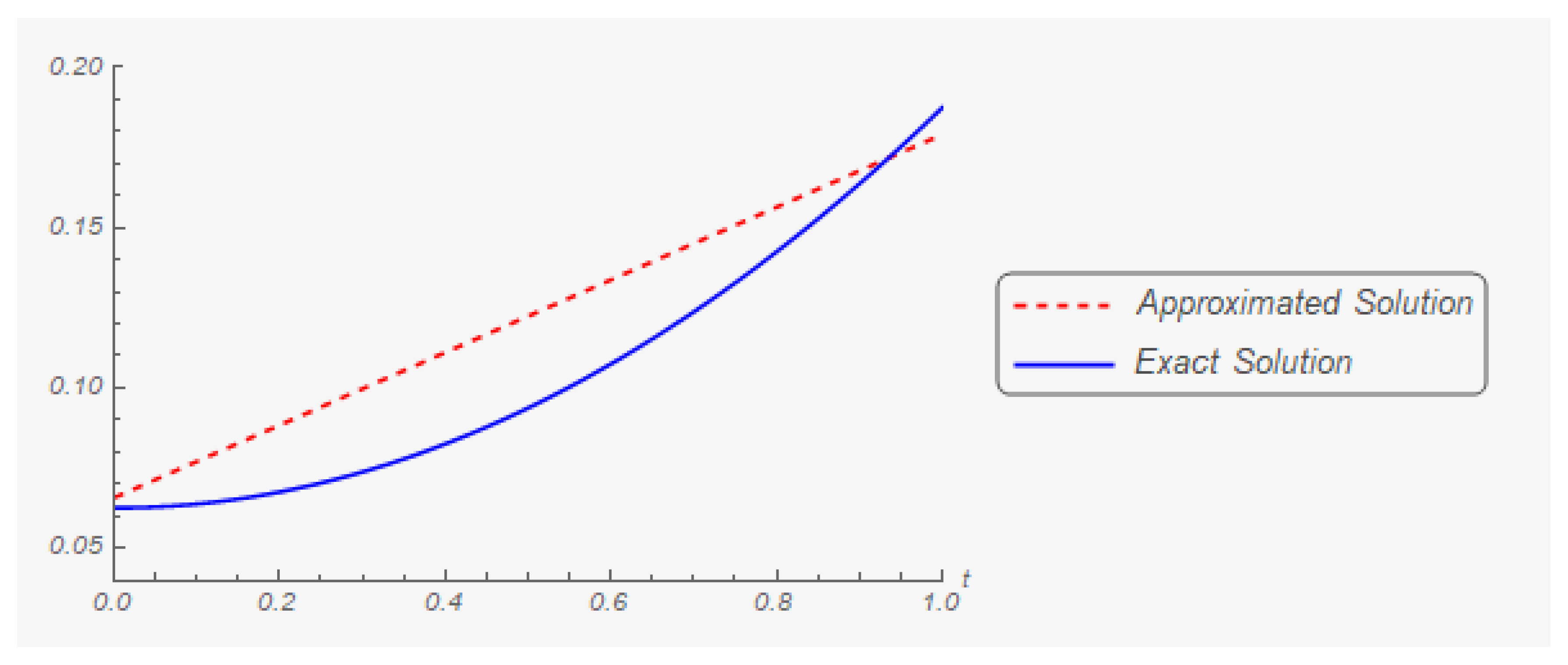
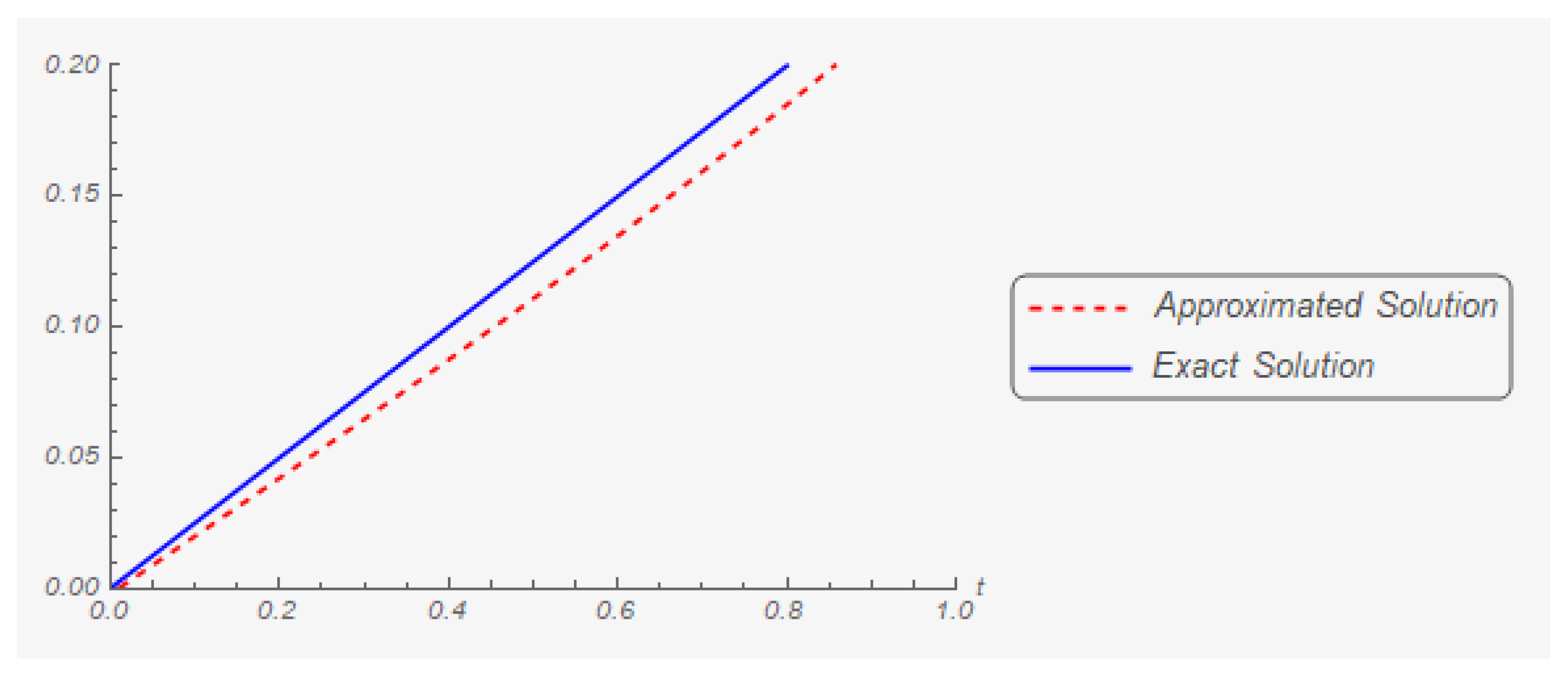
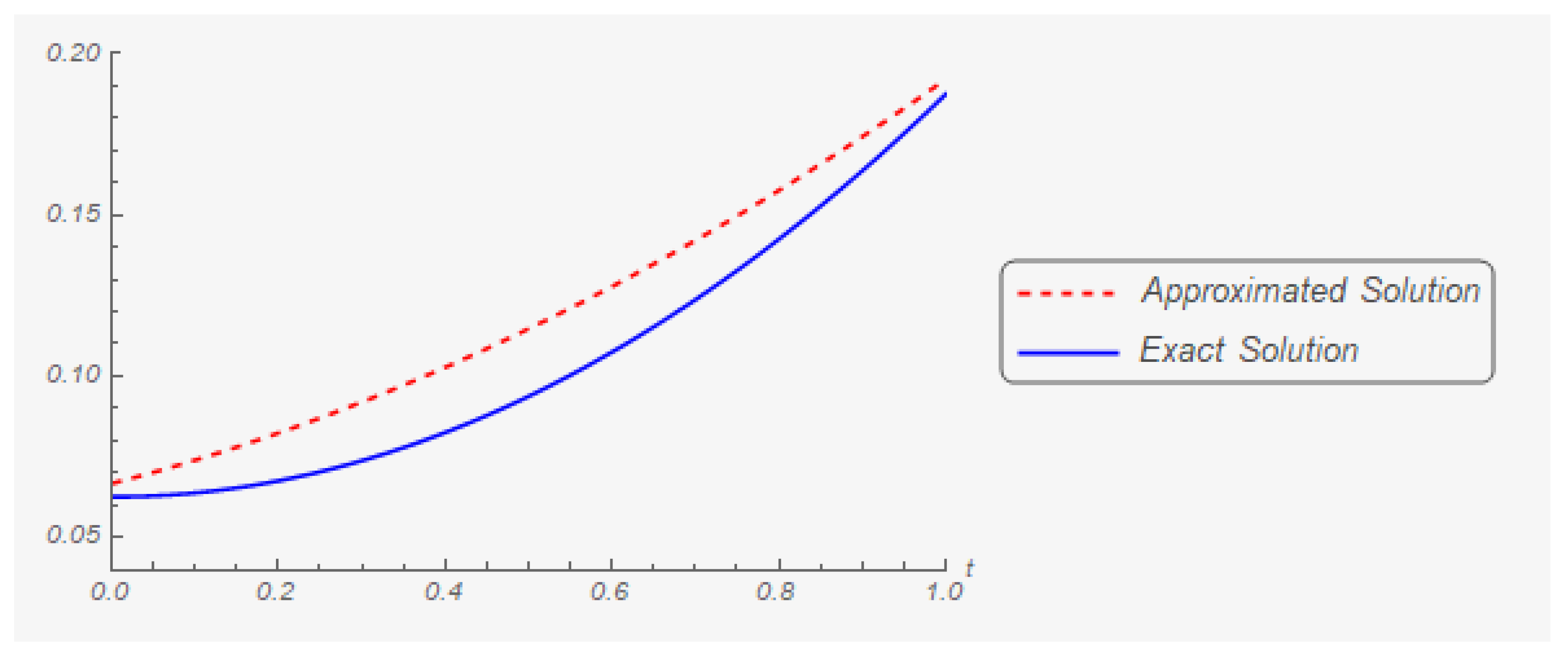


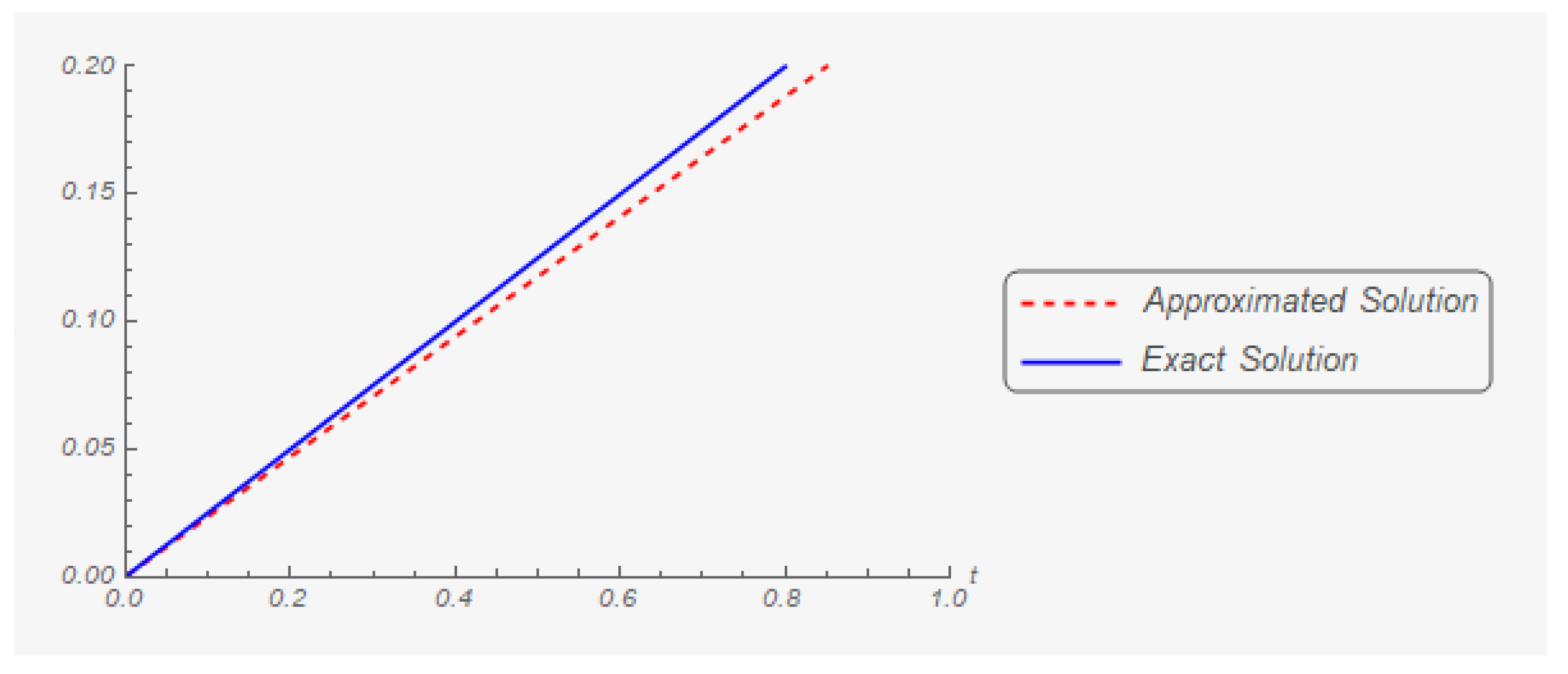
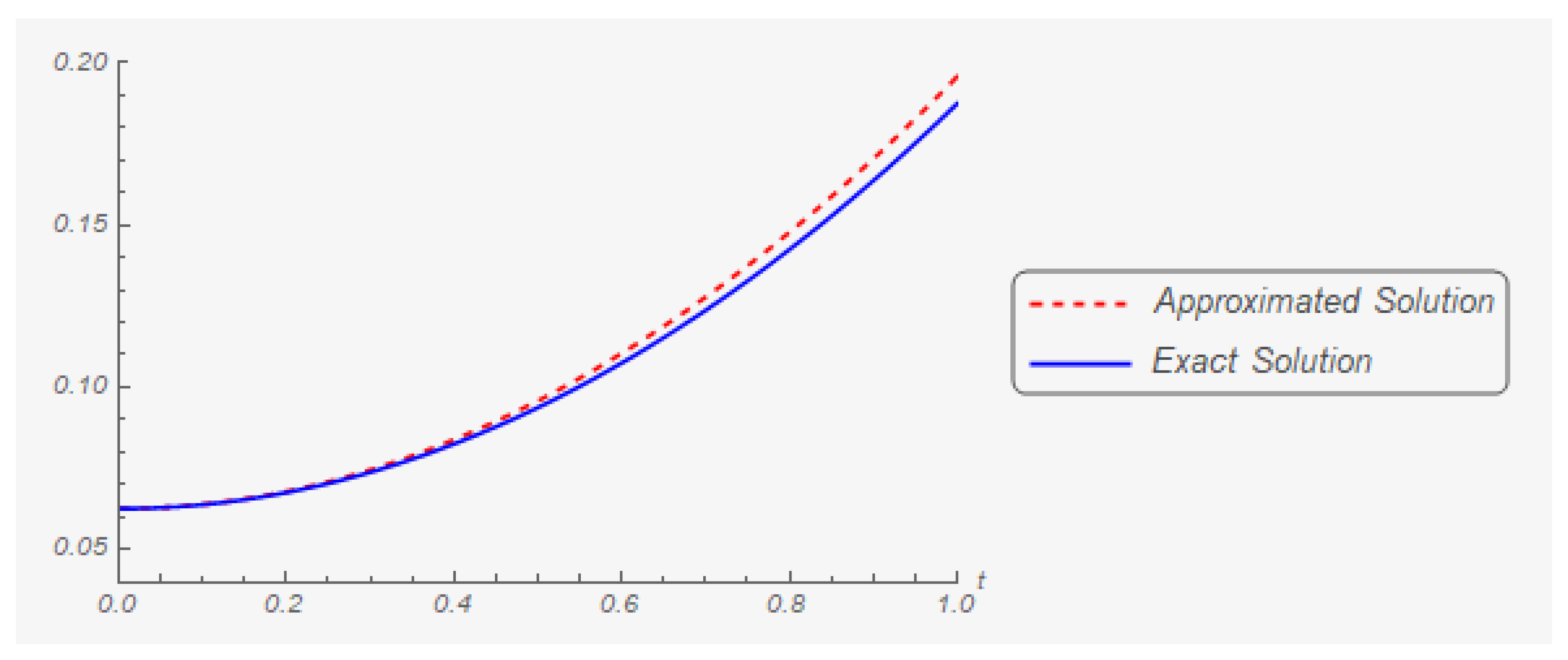

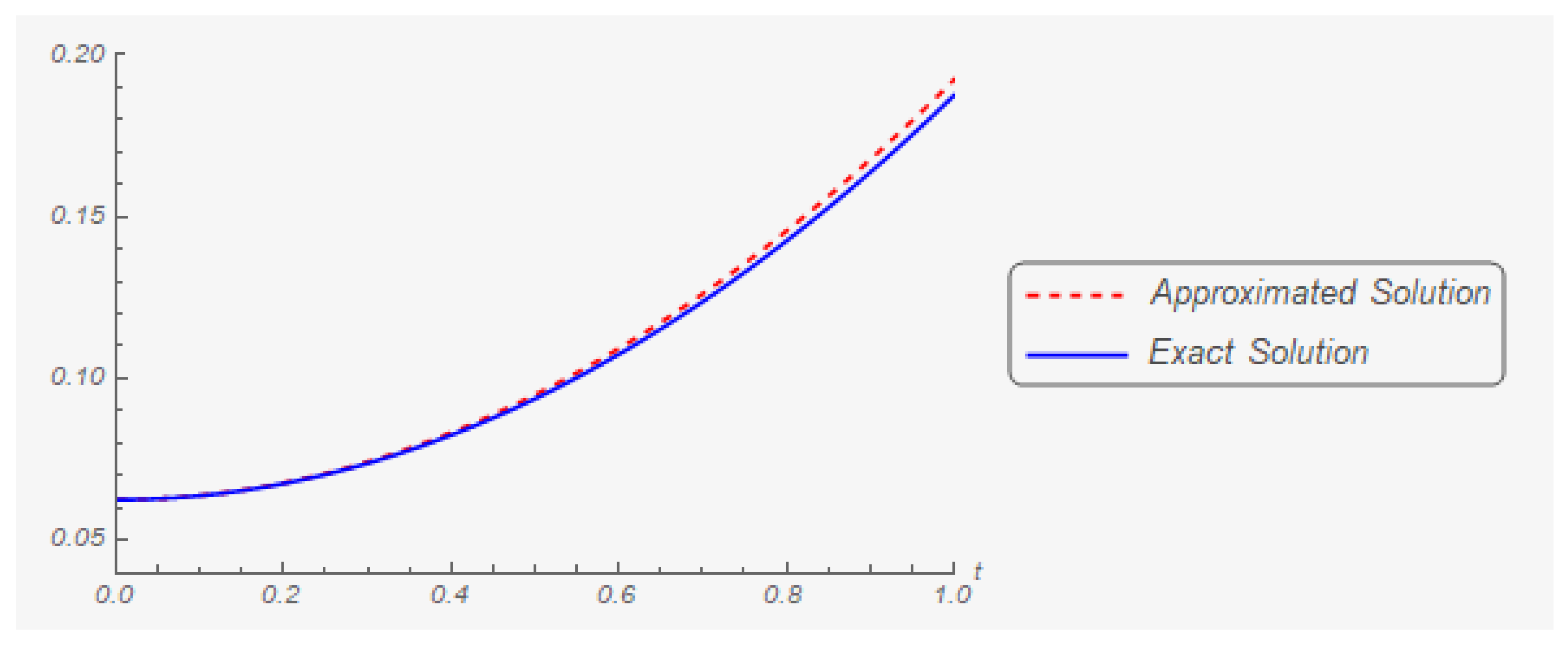
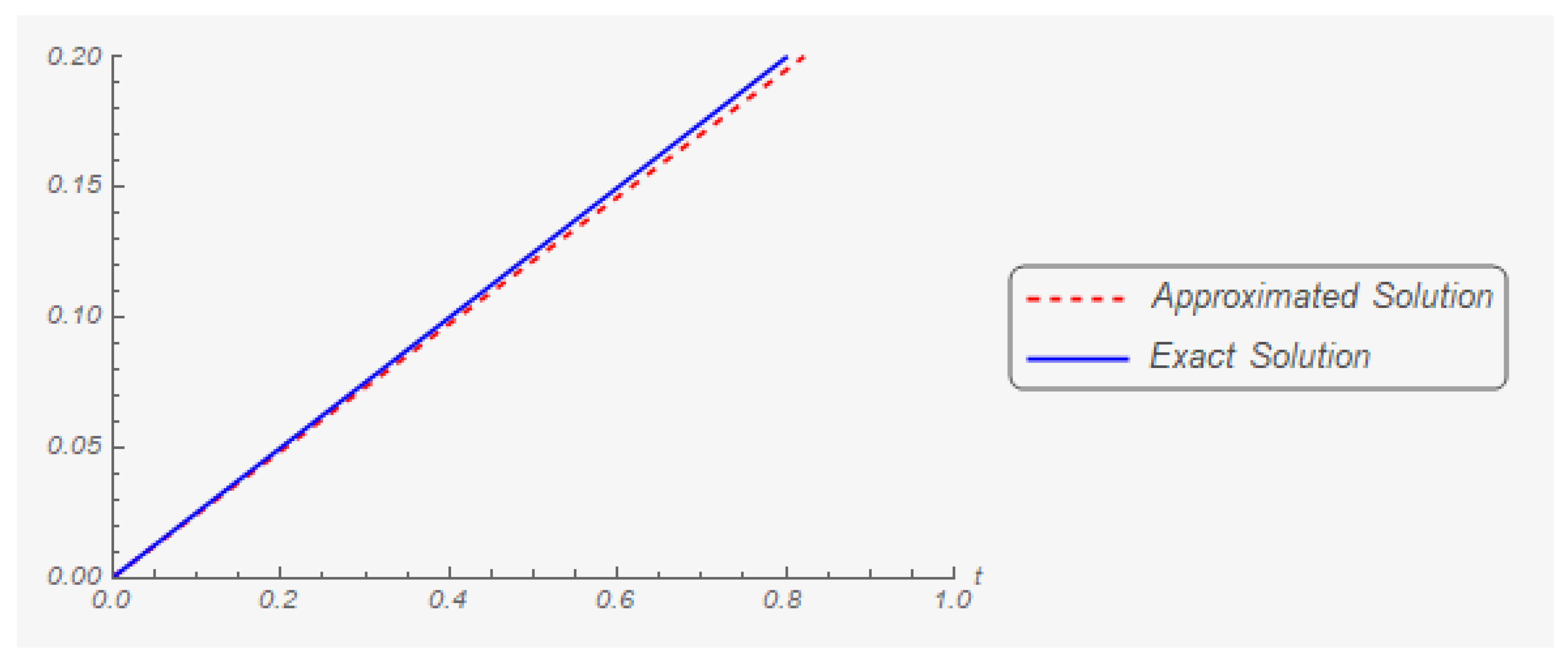
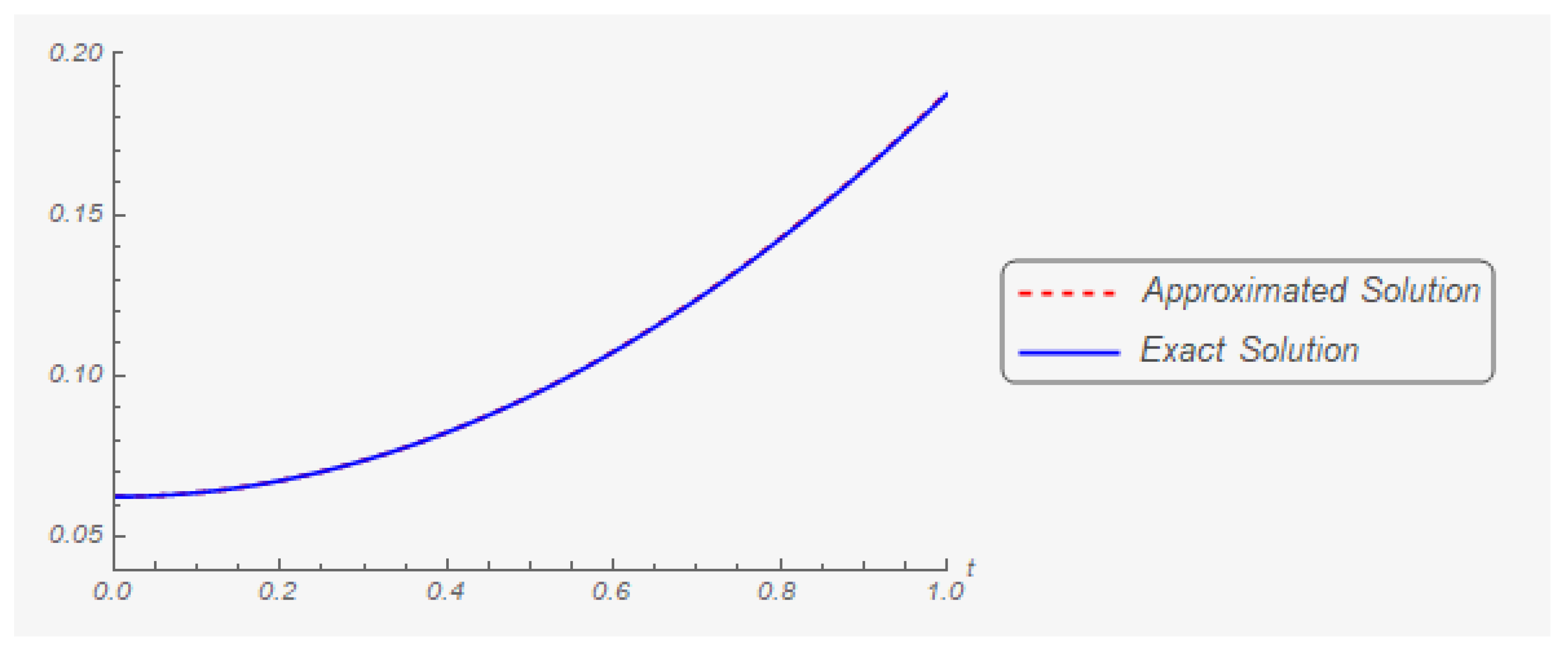

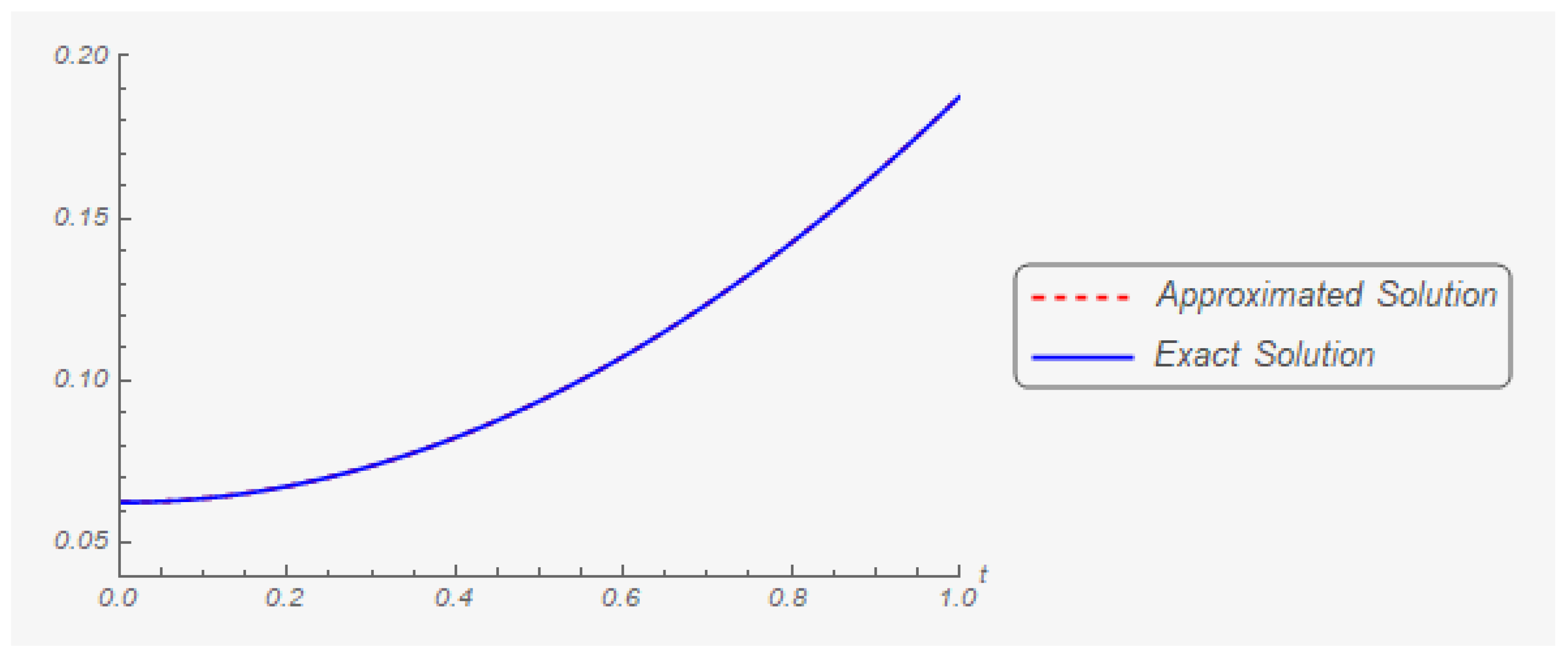
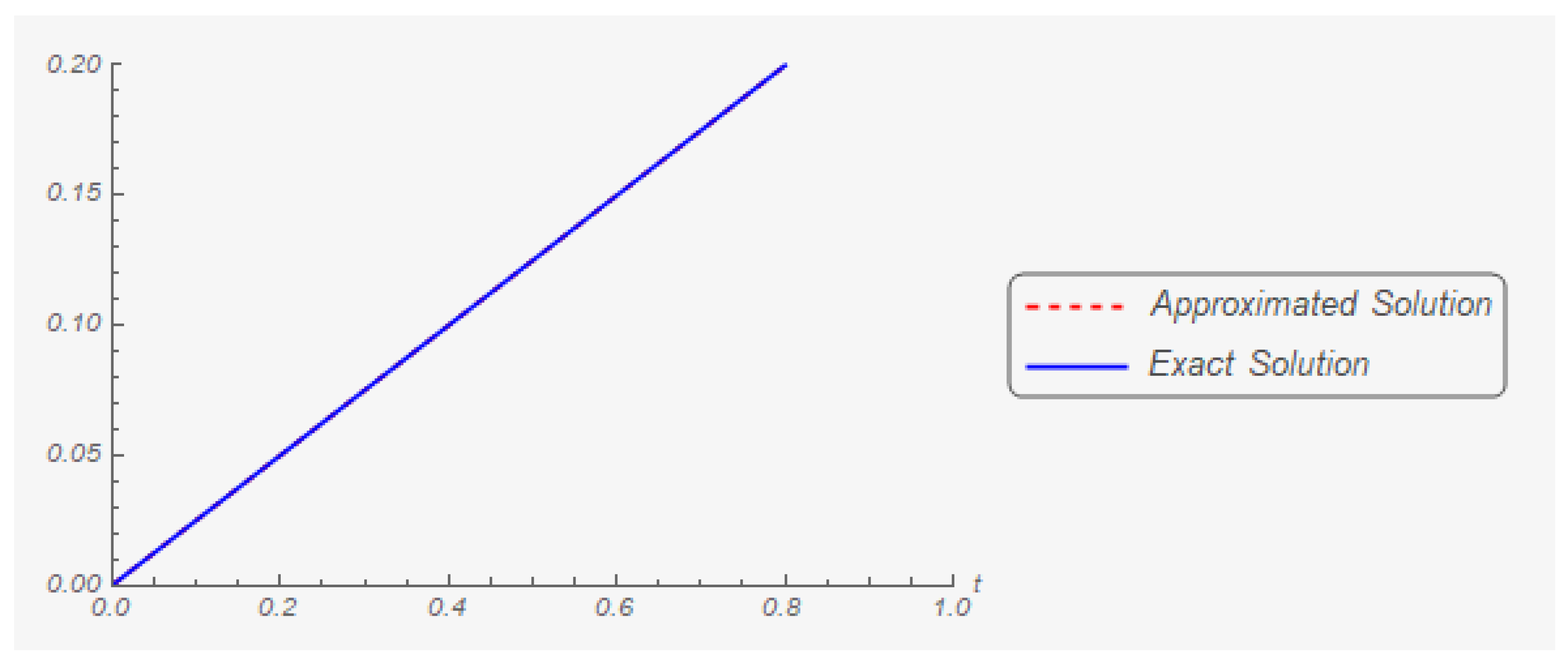
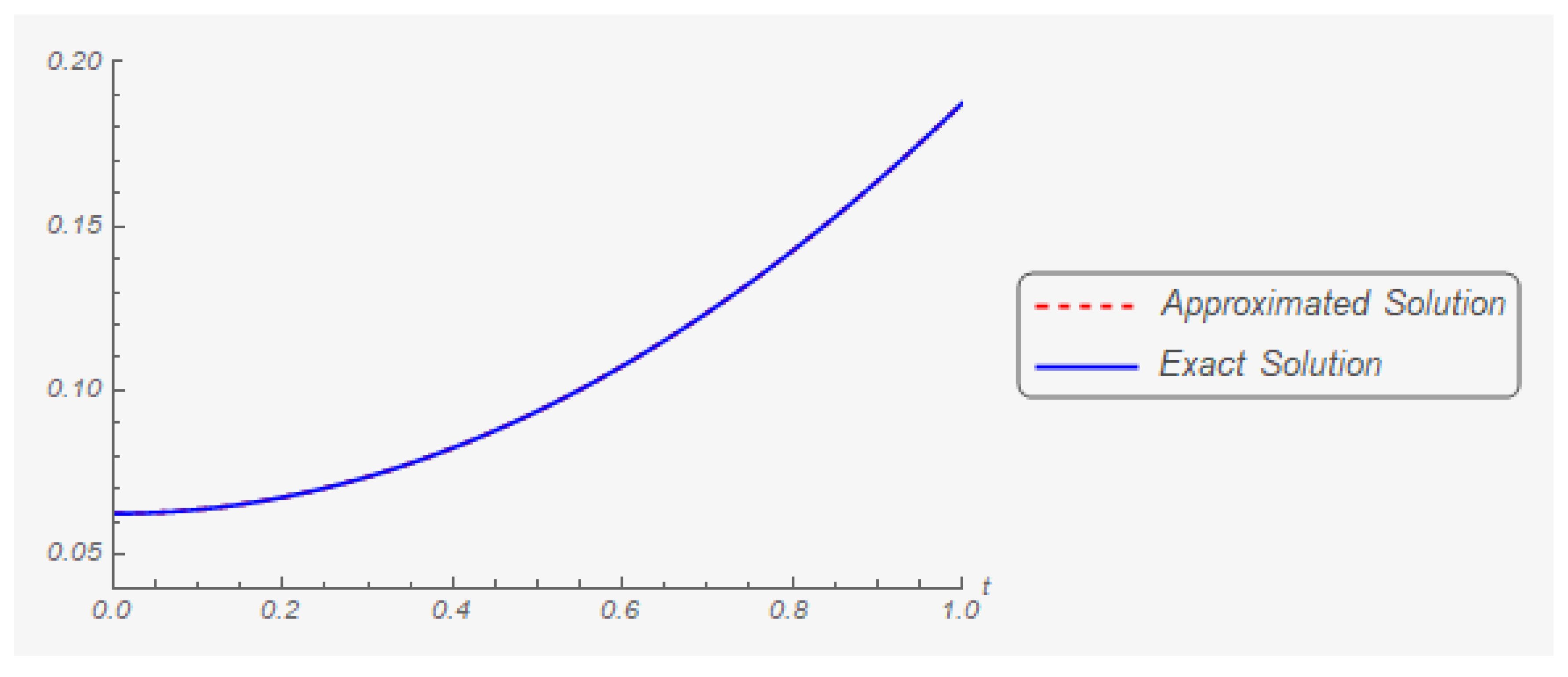

| t | Exact Solution | Approximated Solution | Error | Relative Errors |
|---|---|---|---|---|
| 0.1 | 0.06375 | 0.07704 | 0.01329 | 0.2085 |
| 0.2 | 0.0675 | 0.08838 | 0.02088 | 0.3093 |
| 0.3 | 0.07375 | 0.09973 | 0.02598 | 0.3523 |
| 0.4 | 0.0825 | 0.1111 | 0.02857 | 0.3467 |
| 0.5 | 0.09375 | 0.1224 | 0.02867 | 0.3056 |
| 0.6 | 0.1075 | 0.1338 | 0.02626 | 0.2447 |
| 0.7 | 0.1238 | 0.1451 | 0.02135 | 0.1721 |
| 0.8 | 0.1425 | 0.1564 | 0.01395 | 0.0975 |
| 0.9 | 0.1638 | 0.1678 | 0.00404 | 0.0244 |
| 1 | 0.1875 | 0.1791 | 0.008367 | 0.0448 |
| t | Exact Solution | Approximated Solution | Error | Relative Errors |
|---|---|---|---|---|
| 0.1 | 0.025 | 0.01992 | 0.005082 | 0.2032 |
| 0.2 | 0.05 | 0.04215 | 0.007847 | 0.1570 |
| 0.3 | 0.075 | 0.06464 | 0.01036 | 0.1381 |
| 0.4 | 0.1 | 0.08749 | 0.01251 | 0.1251 |
| 0.5 | 0.125 | 0.1108 | 0.01416 | 0.1136 |
| 0.6 | 0.15 | 0.1348 | 0.01518 | 0.1013 |
| 0.7 | 0.175 | 0.1595 | 0.01546 | 0.0886 |
| 0.8 | 0.2 | 0.1851 | 0.01487 | 0.0745 |
| 0.9 | 0.225 | 0.2117 | 0.01328 | 0.0591 |
| 1 | 0.25 | 0.2394 | 0.01056 | 0.0424 |
| t | Exact Solution | Approximated Solution | Error | Relative Errors |
|---|---|---|---|---|
| 0.1 | 0.06375 | 0.06375 | 1.563 × 10−8 | 2.418 × 10−7 |
| 0.2 | 0.0675 | 0.0675 | 6.25 × 10−8 | 9.2593 × 10−7 |
| 0.3 | 0.07375 | 0.07375 | 1.406 × 10−7 | 1.9064 × 10−6 |
| 0.4 | 0.0825 | 0.0825 | 0.00000025 | 3.0303 × 10−6 |
| 0.5 | 0.09375 | 0.09375 | 3.906 × 10−7 | 4.1664 × 10−6 |
| 0.6 | 0.1075 | 0.1075 | 5.625 × 10−7 | 5.2326 × 10−6 |
| 0.7 | 0.1238 | 0.1238 | 7.656 × 10−7 | 6.1842 × 10−6 |
| 0.8 | 0.1425 | 0.1425 | 0.000001 | 7.0175 × 10−6 |
| 0.9 | 0.1638 | 0.1638 | 0.000001266 | 7.7289 × 10−6 |
| 1 | 0.1875 | 0.1875 | 0.000001563 | 8.3360 × 10−6 |
| t | Exact Solution | Approximated Solution | Error | Relative Errors |
|---|---|---|---|---|
| 0.1 | 0.025 | 0.025 | 0.000000625 | 2.5000 × 10−5 |
| 0.2 | 0.05 | 0.05 | 0.00000125 | 2.5000 × 10−5 |
| 0.3 | 0.075 | 0.075 | 0.000001875 | 2.5000 × 10−5 |
| 0.4 | 0.1 | 0.1 | 0.0000025 | 2.5000 × 10−5 |
| 0.5 | 0.125 | 0.125 | 0.000003125 | 2.5000 × 10−5 |
| 0.6 | 0.15 | 0.15 | 0.00000375 | 2.5000 × 10−5 |
| 0.7 | 0.175 | 0.175 | 0.000004375 | 2.5000 × 10−5 |
| 0.8 | 0.2 | 0.2 | 0.000005 | 2.5000 × 10−5 |
| 0.9 | 0.225 | 0.225 | 0.000005625 | 2.5000 × 10−5 |
| 1 | 0.25 | 0.25 | 0.00000625 | 2.5000 × 10−5 |
© 2019 by the authors. Licensee MDPI, Basel, Switzerland. This article is an open access article distributed under the terms and conditions of the Creative Commons Attribution (CC BY) license (http://creativecommons.org/licenses/by/4.0/).
Share and Cite
Mahmudov, N.I.; Emin, S.; Bawanah, S. On the Parametrization of Caputo-Type Fractional Differential Equations with Two-Point Nonlinear Boundary Conditions. Mathematics 2019, 7, 707. https://doi.org/10.3390/math7080707
Mahmudov NI, Emin S, Bawanah S. On the Parametrization of Caputo-Type Fractional Differential Equations with Two-Point Nonlinear Boundary Conditions. Mathematics. 2019; 7(8):707. https://doi.org/10.3390/math7080707
Chicago/Turabian StyleMahmudov, Nazım I., Sedef Emin, and Sameer Bawanah. 2019. "On the Parametrization of Caputo-Type Fractional Differential Equations with Two-Point Nonlinear Boundary Conditions" Mathematics 7, no. 8: 707. https://doi.org/10.3390/math7080707
APA StyleMahmudov, N. I., Emin, S., & Bawanah, S. (2019). On the Parametrization of Caputo-Type Fractional Differential Equations with Two-Point Nonlinear Boundary Conditions. Mathematics, 7(8), 707. https://doi.org/10.3390/math7080707






